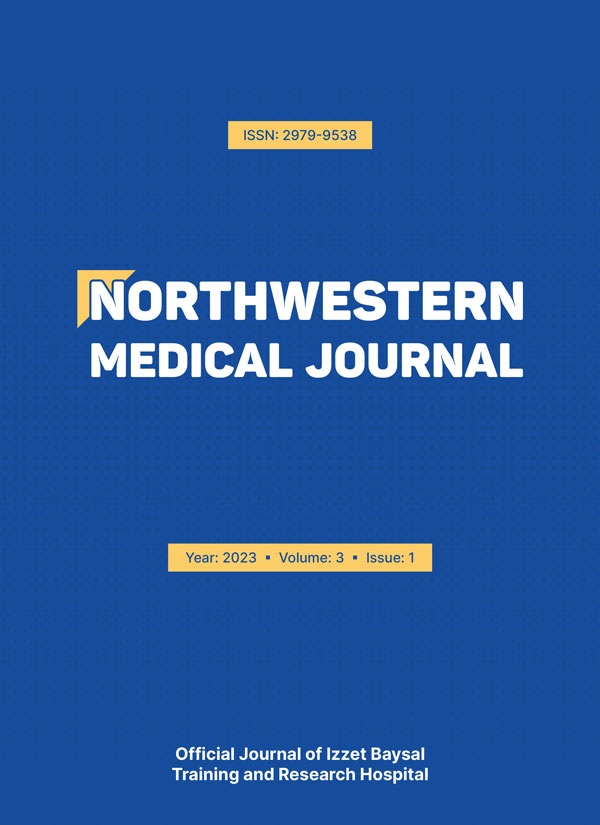Abstract
Aim: Tularemia is a zoonotic disease endemic in the northern hemisphere. The causative agent of the disease is Francisella tularensis. F.tularensis is endemic in Turkey, predominantly in the Marmara and Black Sea regions, and causes small outbreaks. This study aimed to investigate the seroprevalence of F.tularensis in patients admitted to the Otorhinolaryngology outpatient clinic with the complaint of neck mass by using two different methods.
Methods: Serum samples were collected from patients who were admitted to the Otorhinolaryngology outpatient clinic of Dicle University Faculty of Medicine Hospitals between January 2021 and December 2021 with the complaint of neck mass. A commercially available immunochromatographic lateral flow test (ICT) and a single-assay chemiluminescence test (CHT) were used to detect F.tularensis antibodies. Rose-Bengal test was performed on all sera to determine cross-reactions with antibodies produced in brucellosis. Brucella immunocapture agglutination tests (BCT) were performed on the sera of patients with positive screening tests.
Results: The ages of patients diagnosed with neck mass ranged between 14–70 years, with a mean age of 44.5±12.1 years. Sixty two (62%) of the patients were male, and 38 (38%) were female. When the test results were evaluated, two sera were positive for F.tularensis by both ICT and CHT methods. The first serum tests were negative for Brucella. The titer of the second serum in the chemiluminescence test was low positive.
Conclusion: Tularemia should be considered in the differential diagnosis of patients presenting with neck mass complaints, especially in patients living in rural areas, and specific diagnostic tests should be performed. In addition, a more comprehensive seroprevalence study supported by molecular testing techniques to be conducted in Diyarbakır will provide clearer data on the extent to which tularemia affects our region and which subspecies is the causative agent.
Keywords: Neck mass, tularemia, seroprevalence
Copyright and license
Copyright © 2023 The Author(s). This is an open-access article published by Bolu İzzet Baysal Training and Research Hospital under the terms of the Creative Commons Attribution License (CC BY) which permits unrestricted use, distribution, and reproduction in any medium or format, provided the original work is properly cited.
How to cite
References
- Ellis J, Oyston PCF, Green M, Titball RW. Tularemia. Clin Microbiol Rev. 2002; 15(4): 631-46. https://doi.org/10.1128/CMR.15.4.631-646.2002
- Gürcan S. Epidemiology of tularemia. Balkan Med J. 2014; 31(1): 3-10. https://doi.org/10.5152/balkanmedj.2014.13117
- Gürcan S, Otkun MT, Otkun M, Arikan OK, Ozer B. An outbreak of tularemia in Western Black Sea region of Turkey. Yonsei Med J. 2004; 45(1): 17-22. https://doi.org/10.3349/ymj.2004.45.1.17
- T.C. Sağlık Bakanlığı. Tularemi Hastalığının Kontrolü için Saha Rehberi. Ankara: T.C. Sağlık Bakanlığı, Temel Sağlık Hizmetleri Genel Müdürlüğü, Zoonotik Hastalıklar Daire Başkanlığı; 2011. Avilable at: https://web.archive.org/web/20110928232437/http://www.saglik.gov.tr/TR/dosya/1-71840/h/tularemi-saha-rehberi.pdf/
- Şahin İ. Tulareminin bulaş yolları. In: Gürcan Ş, ed. Francisella tularensis ve Tularemi. İstanbul: Nobel Tıp Kitabevleri; 2009: 89-97.
- Bayram Y, Özkaçmaz A, Parlak M, Başbuğan Y, Kılıç S, Güdücüoğlu H. Seroprevalence of tularemia in risk groups of humans and animals in Van, eastern Turkey. Mikrobiyol Bul. 2015; 49(4): 532-41. https://doi.org/10.5578/mb.9966
- Tärnvik A, Priebe HS, Grunow R. Tularaemia in Europe: an epidemiological overview. Scand J Infect Dis. 2004; 36(5): 350-5. https://doi.org/10.1080/00365540410020442
- Uludağ Altun H, Tetik H. Unilateral cervical mass: Tularemia. Ege Journal of Medicine. 2013; 52(1): 43-4.
- Koskela P, Salminen A. Humoral immunity against Francisella tularensis after natural infection. J Clin Microbiol. 1985; 22(6): 973-9. https://doi.org/10.1128/jcm.22.6.973-979.1985
- Çetinkaya Z. Francisella ve Brucella. In: Başustaoğlu A, Kubar A, Yıldıran ŞT, Tanyüksel M, trans. Klinik Mikrobiyoloji. Ankara: Atlas Kitapçılık; 2009: 815-34.
- Wawszczak M, Banaszczak B, Rastawicki W. Tularaemia - a diagnostic challenge. Ann Agric Environ Med. 2022; 29(1): 12-21. https://doi.org/10.26444/aaem/139242
- Arslanyılmaz M, Aslan D, Akın L, Aktaş D. Tularemi: güncel değerlendirmeler. Turk Hij Den Biyol Derg. 2014; 71(2): 99-106. https://doi.org/10.5505/TurkHijyen.2014.50490
- Karadenizli A, Gurcan S, Kolayli F, Vahaboglu H. Outbreak of tularaemia in Golcuk, Turkey in 2005: report of 5 cases and an overview of the literature from Turkey. Scand J Infect Dis. 2005; 37(10): 712-6. https://doi.org/10.1080/00365540510012125
- Helvaci S, Gedikoğlu S, Akalin H, Oral HB. Tularemia in Bursa, Turkey: 205 cases in ten years. Eur J Epidemiol. 2000; 16(3): 271-6. https://doi.org/10.1023/a:1007610724801
- World Health Organization. WHO Guidelines on Tularaemia. Switzerland: WHO Press; 2007. Available at: https://apps.who.int/iris/bitstream/handle/10665/43793/9789241547376_eng.pdf?sequence=1&isAllowed=y
- Akalın H. Ülkemizde Tularemi sorunu. 7. Ulusal İç Hastalıkları Kongresi, Antayla, 2005. Available at: http://www.tihud.org.tr/uploads/content/kongre/7/7.24.pdf
- Karagöz E, Ulçay A, Hatipoğlu M, Turhan V. Tuberculosis and tularemia as part of the differential diagnosis in cervical lymphadenitis. Mikrobiyol Bul. 2014; 48(4): 707-8. https://doi.org/10.5578/mb.7657
- Benli A. First Tularemia Outbreak in the Province of Muş: Evaluation of 50 Cases. Klimik Derg. 2022; 35(2): 74-7. https://doi.org/10.36519/kd.2022.3623
- Gürcan Ş. Serolojik Tanı Yöntemleri. In: Gürcan Ş, ed. Francisella tularensis ve Tularemi. İstanbul: Nobel Tıp Kitabevleri; 2009: 269-72.
- Dedeoğlu GK, Gürcan S, Eskiocak M, Kılıç H, Kunduracılar H. Trakya bölgesi köylerinde tularemi seroprevalansının araştırılması. Mikrobiyol Bul. 2007; 41(3): 411-8.
- Esmaeili S, Gooya MM, Shirzadi MR, et al. Seroepidemiological survey of tularemia among different groups in western Iran. Int J Infect Dis. 2014; 18: 27-31. https://doi.org/10.1016/j.ijid.2013.08.013
- Yazgi H, Uyanik MH, Ertek M, et al. Erzurum merkez ve kırsalında yaşayan riskli gruplarda tularemi seroprevalansı. Mikrobiyol Bul. 2011; 45(1): 67-74.
- Atmaca S, Leblebicioğlu H, Ünal R, et al. Samsun ve çevresinde görülen tularemi olgulari. KBB-Forum. 2005; 4(4): 171-2.
- Yeşilyurt M, Kılıç S, Çelebİ B, Gül S. Tularemi: Avcılar Gerçekten Bir Risk Grubu mu? Mikrobiyol Bul. 2012; 46(1): 153-5.
- Bozdağ H, Özekinci T. Tularemia in Diyarbakır Province and its Surroundings: A Rarely Known Disease. İKSSTD. 2020; 12(1): 52-6. https://doi.org/10.5222/iksstd.2020.48243
- Yıldırım M. Türkiye’de Tularemi: Seroprevalans Çalışmaları, Francisella tularensis ve Tularemi. Gürcan S, editor. İstanbul: Nobel Tıp Kitabevleri; 2008: 299-304.
- Porsch-Ozcürümez M, Kischel N, Priebe H, Splettstösser W, Finke E-J, Grunow R. Comparison of enzyme-linked immunosorbent assay, Western blotting, microagglutination, indirect immunofluorescence assay, and flow cytometry for serological diagnosis of tularemia. Clin Diagn Lab Immunol. 2004; 11(6): 1008-15. https://doi.org/10.1128/CDLI.11.6.1008-1015.2004
- Kılıç S, Çelebi B, Bayram Y, Çitil B. Francisella tularensis antikorları ile Brucella çapraz reaksiyonlarının araştırılması. Turk Hij Den Biyol Derg. 2013; 70(2): 65-70. https://doi.org/10.5505/TurkHijyen.2013.70893











